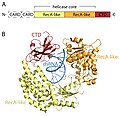RIG-I-like receptor
RIG-I-like receptors (RLRs) are a type of pattern recognition receptor (PRR) that are key components of the innate immune system. They are cytosolic receptors, meaning they are found within the cytoplasm of a cell, and they are responsible for detecting viral RNA and initiating an immune response.
Function
RLRs are responsible for recognizing viral RNA within the cytoplasm of a cell. When they detect viral RNA, they initiate a signaling cascade that leads to the production of interferons and other cytokines. These molecules then help to coordinate the immune response to the virus.
There are three main types of RLRs: RIG-I, MDA5, and LGP2. Each of these receptors recognizes different types of viral RNA, allowing the immune system to respond to a wide variety of viruses.
RIG-I
RIG-I (Retinoic acid-inducible gene I) is an RLR that recognizes short double-stranded RNA and 5'-triphosphate RNA. It is essential for the immune response to RNA viruses such as influenza virus and hepatitis C virus.
MDA5
MDA5 (Melanoma differentiation-associated protein 5) is an RLR that recognizes long double-stranded RNA. It is important for the immune response to picornaviruses, which are a type of RNA virus.
LGP2
LGP2 (Laboratory of genetics and physiology 2) is an RLR that does not have a signaling domain, and its role in the immune response is not fully understood. However, it is thought to regulate the activity of RIG-I and MDA5.
Clinical significance
Mutations in the genes encoding RLRs can lead to immune disorders. For example, mutations in the gene encoding MDA5 have been associated with a type of autoimmune disease called Aicardi-Goutières syndrome.
Furthermore, the activity of RLRs is also important in the context of autoimmunity and cancer. For example, overactivation of RLRs can lead to excessive production of interferons, which can contribute to autoimmune disease. On the other hand, activation of RLRs can also stimulate the immune response against cancer cells.
See also
Transform your life with W8MD's budget GLP-1 injections from $125.
W8MD offers a medical weight loss program to lose weight in Philadelphia. Our physician-supervised medical weight loss provides:
- Most insurances accepted or discounted self-pay rates. We will obtain insurance prior authorizations if needed.
- Generic GLP1 weight loss injections from $125 for the starting dose.
- Also offer prescription weight loss medications including Phentermine, Qsymia, Diethylpropion, Contrave etc.
NYC weight loss doctor appointments
Start your NYC weight loss journey today at our NYC medical weight loss and Philadelphia medical weight loss clinics.
- Call 718-946-5500 to lose weight in NYC or for medical weight loss in Philadelphia 215-676-2334.
- Tags:NYC medical weight loss, Philadelphia lose weight Zepbound NYC, Budget GLP1 weight loss injections, Wegovy Philadelphia, Wegovy NYC, Philadelphia medical weight loss, Brookly weight loss and Wegovy NYC
|
WikiMD's Wellness Encyclopedia |
| Let Food Be Thy Medicine Medicine Thy Food - Hippocrates |
Medical Disclaimer: WikiMD is not a substitute for professional medical advice. The information on WikiMD is provided as an information resource only, may be incorrect, outdated or misleading, and is not to be used or relied on for any diagnostic or treatment purposes. Please consult your health care provider before making any healthcare decisions or for guidance about a specific medical condition. WikiMD expressly disclaims responsibility, and shall have no liability, for any damages, loss, injury, or liability whatsoever suffered as a result of your reliance on the information contained in this site. By visiting this site you agree to the foregoing terms and conditions, which may from time to time be changed or supplemented by WikiMD. If you do not agree to the foregoing terms and conditions, you should not enter or use this site. See full disclaimer.
Credits:Most images are courtesy of Wikimedia commons, and templates, categories Wikipedia, licensed under CC BY SA or similar.
Contributors: Prab R. Tumpati, MD


